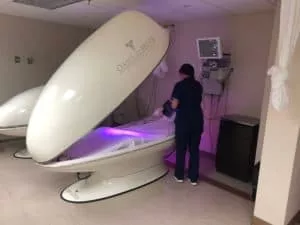What is PDT?
Photodynamic therapy (PDT) is a treatment that uses a light source and light-sensitive drugs to kill malignant and precancerous cells.
A wavelength of light radiation, generally from a laser, activates photosensitizers.
The photosensitizer is harmless until it is activated by light. The photosensitizer becomes poisonous to the targeted tissue after being activated by light.
How Does Photodynamic Therapy Work?
Photodynamic therapy is a two-step process.
Step 1: Light-Sensitive Drug
The patient is taking a light-sensitive medicine (photosensitizer). The photosensitizer in photodynamic therapy may be taken orally, applied to the skin, or given through an IV.
After taking the medication, there is a time to wait before the next step to allow the medication to build up in the cancer cells.
Most medicine will stay a short time in the normal cells but will remain in cancer or pre-cancer cells.
Step 2: Light Exposure
The tumor is exposed to a light source. The location of the tumor determines the way the light is applied.
The light is directed precisely toward cancer in the case of skin tumors.
For treating internal tumors, the doctor may use an endoscope. Once the endoscope is in position, the doctor inserts a fiber optic cable which sends light to the treatment locations.
Most patients will receive photodynamic therapy as an outpatient, which means they will go home following treatment and will not be admitted to the hospital for the night. Photodynamic therapy can be used alone or in combination with other cancer treatments.
What are the Side Effects of Photodynamic Therapy?
- Swelling at or near the area of skin treated
- Scales, crusts, or blisters on your skin receive treatment.
- Itching, stinging or burning, Skin infections.
- Cough, trouble swallowing
- Stomach pain
- Painful breathing
Photodynamic Therapy For Cancer
Photodynamic therapy is used to treat a variety of conditions, including:
- Pancreatic cancer.
- Bile duct cancer (cholangiocarcinoma)
- Oesophageal cancer
- Precancerous skin changes (actinic keratosis)
- Non-melanoma skin cancer
- Lung cancer
- Head and neck
- Breast
- Prostate
Dr. Weber explains photodynamic therapy in combination with a photosensitizer, infrared laser light, ultrasound, and shockwaves as stimulants:
You can get photodynamic therapy in a few alternative cancer clinics. Some clinics also offer Sono-photodynamic therapy, which uses both light and sound.








